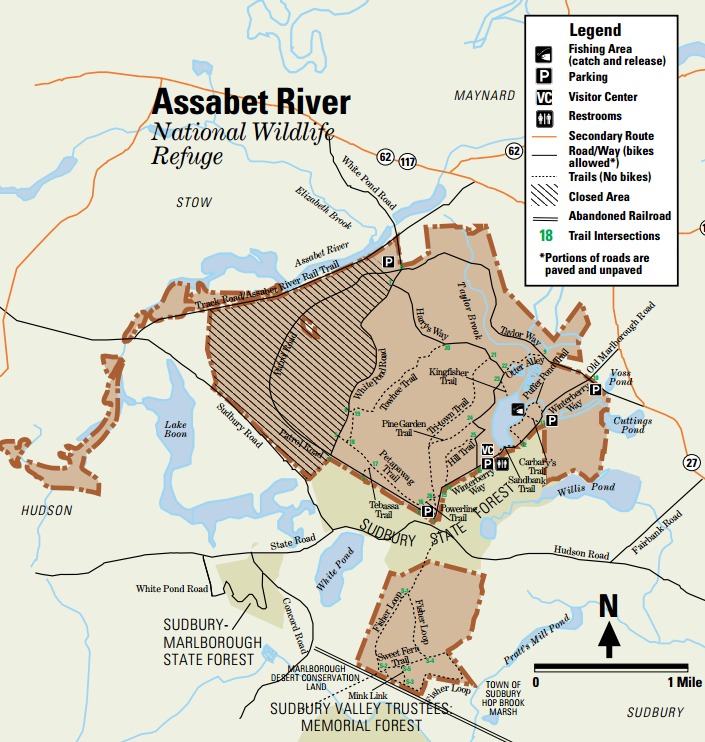Assabet River NWR

Assabet River NWR
Important Bird Area Sudbury, Massachusetts 01776
Official WebsiteAssabet River National Wildlife Refuge Important Bird Area
Friends of Assabet River National Wildlife Refuge webpage
Assabet River National Wildlife Refuge map
Assabet River National Wildlife Refuge trail map
Birds of Interest
Least Bittern, probable breeder; Cooper’s Hawk, confirmed breeder; King Rail.
There is a great diversity of land bird species at this inland site.
The rare, unique, or representative habitats include an Atlantic White Cedar swamp, a small sandy-bottom kettle hole pond, several dwarf shrub bogs, open canopy minerotrophic peatlands, and areas of exposed sands. These community types are relatively infrequent in this area and harbor species uncommon to the region.
The USFWS has instituted long-term breeding bird surveys, marsh bird surveys, and hawk watches.
About this Location
This Important Bird Area is composed of the Assabet River National Wildlife Refuge (ARNWR), newly acquired by the US Fish and Wildlife Service (USFWS), and adjacent undeveloped areas to the west and south. To the south of the refuge, the proposed IBA includes sections of Marlborough-Sudbury State Forest, the General Federation of Women’s Clubs of Massachusetts Memorial Forest in Marlborough and Sudbury, the town of Sudbury Hop Brook Marsh conservation area, the city of Marlborough Desert Conservation Land, and undeveloped private land. Historically, the land that now makes up the ARNWR was farmed until it was acquired by the military for use as an ammunition depot during World War II. The forests are all second-growth since before 1942 the property was farmed. The proposed IBA is composed largely of forests interspersed with wetlands. The landscape shows clear evidence of glacial activity including moraines, an esker, and kettle holes. The soils throughout much of the area are sandy, supporting a Pitch Pine and Scrub Oak forest. There is an Atlantic White Cedar swamp that straddles the border between the east side of the refuge and the Marlborough-Sudbury State Forest and extends onto unprotected private property. Several unconnected small grasslands were maintained for military usage before the transfer.
The land is primarily owned by USFWS but includes undeveloped and unprotected private lands. At ARNWR, there are a series of sealed ammunition bunkers and decaying structures that date to the period of army usage. The refuge is closed to the public until the hazards associated with these decaying structures can be mitigated. USFWS has either applied or is considering the appropriate methods to control invasive species. These species include Japanese Knotweed, Spotted Knapweed, Common Reed, and Purple Loosestrife. The Purple Loosestrife is being biologically controlled.
Assabet River National Wildlife Refuge encompasses 3.5 square miles located within the towns of Hudson, Maynard, Stow, and Sudbury approximately 20 miles west of Boston. Formerly part of Fort Devens, this area was known as the Sudbury Training Annex. The U.S. Army transferred 2,332 acres to the U.S. Fish and Wildlife Service in the fall of 2000.
The refuge has a large wetland complex, several smaller wetlands and vernal pools, and large forested areas which are important feeding and breeding areas for migratory birds and other wildlife. It also has 15 miles of trails (half are open to biking) open to the public for the enjoyment of nature as well as a visitor center located on Winterberry Way. Our primary purpose is to manage these lands for migratory bird conservation. The refuge is one of eight national wildlife refuges that comprise the Eastern Massachusetts National Wildlife Refuge Complex.
Features
Restrooms on site
Roadside viewing
Wheelchair accessible trail
Entrance fee
Content from Official Website and Assabet River National Wildlife Refuge Important Bird Area
Last updated December 21, 2023
